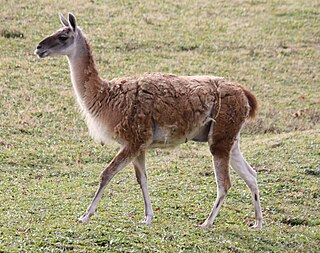
The rodent subfamily Sigmodontinae includes New World rats and mice, with at least 376 species. Many authorities include the Neotominae and Tylomyinae as part of a larger definition of Sigmodontinae. When those genera are included, the species count numbers at least 508. Their distribution includes much of the New World, but the genera are predominantly South American, such as brucies. They invaded South America from Central America as part of the Great American Interchange near the end of the Miocene, about 5 million years ago. Sigmodontines proceeded to diversify explosively in the formerly isolated continent. They inhabit many of the same ecological niches that the Murinae occupy in the Old World.

Euryoryzomys nitidus, also known as the elegant oryzomys or elegant rice rat, is a rodent species in the family Cricetidae. Previously it was known as Oryzomys nitidus, but it is not closely related to Oryzomys as that genus is now constructed. Its range includes Bolivia, Brazil and Peru to the east of the Andes, in lowland tropical rainforest as well as forest in the eastern foothills of the mountains, at elevations from 50 to 2,000 m.
Oligoryzomys microtis, also known as the small-eared colilargo or small-eared pygmy rice rat, is a species of rodent in the genus Oligoryzomys of family Cricetidae. It is found in western Brazil, eastern Peru, Bolivia, and northern Paraguay.
Neacomys dubosti, also known as Dubost's neacomys or Dubost's bristly mouse, is a species of South American rodent in the genus Neacomys of family Cricetidae. It is found in French Guiana, southeastern Suriname and nearby Amapá, Brazil. It was not recognized as distinct from N. guianae until 2001.
Neacomys guianae, also known as the Guianan neacomys or Guiana bristly mouse, is a nocturnal rodent species from South America. It is found in lowland tropical rainforests in northeastern Brazil, French Guiana, Guyana, Suriname and Venezuela. Its diet consists of insects, seeds and fruit.
Neacomys minutus, also known as the minute neacomys, the small bristly mouse, or the minute spiny mouse, is a rodent species from South America in the genus Neacomys. It is found in Brazil.
Neacomys musseri, also known as Musser's neacomys or Musser's bristly mouse, is a rodent species from South America. It is found in far western Brazil and southeastern Peru.
Neacomys paracou, also known as the Paracou neacomys or Paracou bristly mouse, is a rodent species from South America in the genus Neacomys. It is found in northern Brazil, French Guiana, Guyana, Suriname and southeastern Venezuela.

The white-footed climbing mouse is a species of South American rodent found in Bolivia, Brazil, Ecuador, French Guiana, Guyana, Peru, Suriname and Venezuela. It is the type species of the genus and the type location was the lower eastern slopes of the Andes in central Peru.
Scolomys ucayalensis, also known as the long-nosed scolomys or Ucayali spiny mouse is a nocturnal rodent species from South America. It is part of the genus Scolomys within the tribe Oryzomyini. It is found in Brazil, Colombia, Ecuador and Peru in various different habitats in the Amazon rainforest.
The genus Neacomys, also known as bristly mice because of their spiny fur, includes several species of rodents in the tribe Oryzomyini of family Cricetidae. It is most closely related to Oligoryzomys, Oreoryzomys, and Microryzomys. Neacomys species are mainly found in the Amazon basin, but N. pictus occurs in Panama and N. tenuipes in montane Colombia.

The fauna of the Andes, a mountain range in South America, is large and diverse. As well as a huge variety of flora, the Andes contain many different animal species.
Microryzomys altissimus, also known as the Páramo colilargo or highland small rice rat, is a species of rodent in the genus Microryzomys of family Cricetidae. It is found in Colombia, Ecuador, and Peru, but the Colombian segment may be a separate species.
Microryzomys is a genus of rodent in the tribe Oryzomyini of family Cricetidae. It is closely related to Oreoryzomys, Oligoryzomys, and Neacomys. It contains two species, both restricted to the Andes: M. altissimus and M. minutus.
Microryzomys minutus, also known as the montane colilargo or the forest small rice rat, is a species of rodent in the genus Microryzomys of family Cricetidae. It is found in Bolivia, Colombia, Ecuador, Peru, and Venezuela, but these populations may represent more than one species.
Oligoryzomys destructor, also known as Tschudi's colilargo or the destructive pygmy rice rat, is a species of rodent in the genus Oligoryzomys of family Cricetidae. It is found along the eastern Andes from southern Colombia, through Ecuador, Peru, and Bolivia into northern Argentina. Its karyotype has 2n = 60 and FNa = 76.
Coues's climbing mouse is a species of rodent in the family Cricetidae. It is found in Colombia, Ecuador, Peru, Trinidad and Tobago, and Venezuela. It is named in honour of the American zoologist Elliott Coues who studied birds and small mammals.
The golden Oldfield mouse or golden thomasomys is a species of rodent in the family Cricetidae. It is found in Colombia, Ecuador, Peru, and Venezuela. Both the common and genus name commemorate the British zoologist Oldfield Thomas who worked at the Natural History Museum, London and studied South American rodents.
The long-tongued arboreal mouse is a South American rodent species of the family Cricetidae. It is found in a variety of habitats, including dense forest, in Bolivia and Peru at elevations from 450 to 2,100 metres on the eastern side of the Andes. The species is at least partly arboreal. It is distinguished from the Brazilian arboreal mouse, the only other known member of Rhagomys, by spiny fur and certain skull features such as the presence of beading in the interorbital region.




